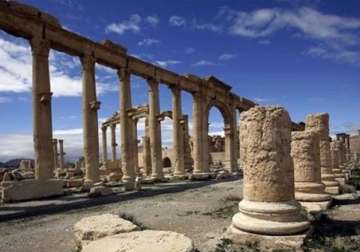Islamic State militants reportedly captured the ancient Syrian town of Palmyra Wednesday as Syrian officials evacuated citizens and scrambled to keep priceless antiquities from falling into terrorist hands.
The Syrian Observatory for human rights told The Associated Press that government forces collapsed in the face of ISIS attacks and withdrew from the town late Wednesday. The Wall Street Journal reported that before fleeing, the National Defense Forces evacuated civilians as militants took control of residential areas and established themselves in the city's nearby ruins.
It was not immediately clear how close to Palmyra's famed archeological site ISIS forces had come, but Syrian activists said that Syrian soldiers were seen fleeing the area.
Hundreds of statues have been moved from Palmyra to safe locations, Syria's antiquities chief told Reuters.
"Hundreds and hundreds of statues we were worried would be smashed and sold are all now in safe places," Maamoun Abdulkarim told Reuters, but voiced his concern about Palmyra's museum and large monuments that cannot be moved. "This is the entire world's battle,” he added.
Palmyra dates back to the second millennium B.C. A UNESCO World Heritage site, the city was one of the most important cultural centers of the ancient world and has been home to Arabic, Aramaic, and Greco-Roman culture. Palmyra contains numerous monumental ruins, including the Temple of Ba'al, an ancient theater, and its famous colonnade.
"Given ISIS' past actions, moving the statues is a vital precaution," Christopher Jones, a graduate student in ancient Near Eastern history at Columbia University and author of the Gates of Nineveh blog, told FoxNews.com. "The ruins themselves are still under threat though even if there are no statues."
Should ISIS take full control of the town, it would be the group's second major victory in a week, coming just days after militants in Iraq secured the key city of Ramadi, capital of the Anbar province, causing thousands of refugees to flee to neighboring Baghdad.
According to the International Organization for Migration, more than 40,000 people have been displaced from Anbar since Friday when the militants began their final push for the city.
Athal al-Fahdawi, an Anbar councilman, said that thousands of refugees who were stranded on open land for days, were being allowed to cross a bridge spanning the Euphrates River and enter Baghdad.
An estimated 500 soldiers and civilians were killed in Ramadi after ISIS took the city with a well-coordinated wave of truck bombs that paved the way for fighters to pour in and rout dug-in Iraqi forces.
Palmyra would also be a key strategic capture for ISIS, allowing militants to advance to key government-held areas such as Damascus and the Syrian coast to the south and southwest. Palmyra is also located near important gas and oil fields.
ISIS has launched a series of wanton attacks on sites of historic and religious importance. Earlier this year ISIS released a video showing militants using sledgehammers and drills to destroy artifacts in Iraq's Mosul Museum.
Experts also have warned that militants smuggled priceless Iraqi artifacts out of the country for sale on the black market to fund the terrorist army.
Latest World News
